Walid Ahmed
Continuous Self-Improvement of Large Language Models by Test-time Training with Verifier-Driven Sample Selection
May 26, 2025Abstract:Learning to adapt pretrained language models to unlabeled, out-of-distribution data is a critical challenge, as models often falter on structurally novel reasoning tasks even while excelling within their training distribution. We introduce a new framework called VDS-TTT - Verifier-Driven Sample Selection for Test-Time Training to efficiently address this. We use a learned verifier to score a pool of generated responses and select only from high ranking pseudo-labeled examples for fine-tuned adaptation. Specifically, for each input query our LLM generates N candidate answers; the verifier assigns a reliability score to each, and the response with the highest confidence and above a fixed threshold is paired with its query for test-time training. We fine-tune only low-rank LoRA adapter parameters, ensuring adaptation efficiency and fast convergence. Our proposed self-supervised framework is the first to synthesize verifier driven test-time training data for continuous self-improvement of the model. Experiments across three diverse benchmarks and three state-of-the-art LLMs demonstrate that VDS-TTT yields up to a 32.29% relative improvement over the base model and a 6.66% gain compared to verifier-based methods without test-time training, highlighting its effectiveness and efficiency for on-the-fly large language model adaptation.
Balancing Computation Load and Representation Expressivity in Parallel Hybrid Neural Networks
May 26, 2025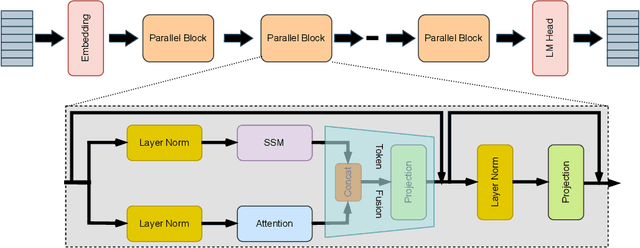
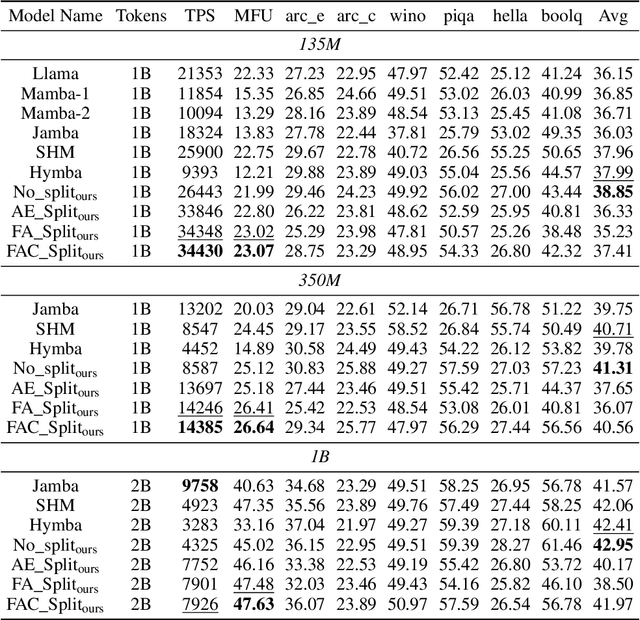
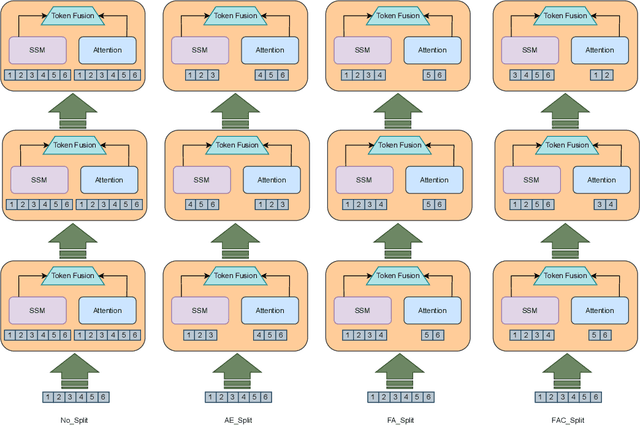
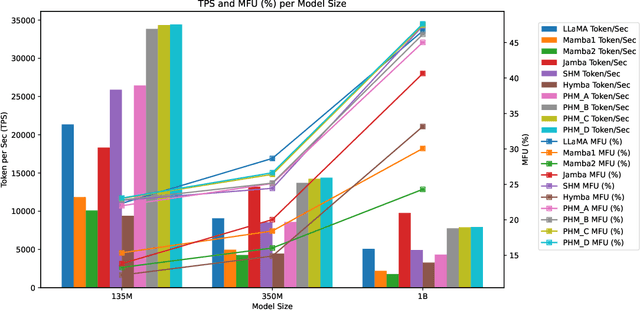
Abstract:Attention and State-Space Models (SSMs) when combined in a hybrid network in sequence or in parallel provide complementary strengths. In a hybrid sequential pipeline they alternate between applying a transformer to the input and then feeding its output into a SSM. This results in idle periods in the individual components increasing end-to-end latency and lowering throughput caps. In the parallel hybrid architecture, the transformer operates independently in parallel with the SSM, and these pairs are cascaded, with output from one pair forming the input to the next. Two issues are (i) creating an expressive knowledge representation with the inherently divergent outputs from these separate branches, and (ii) load balancing the computation between these parallel branches, while maintaining representation fidelity. In this work we present FlowHN, a novel parallel hybrid network architecture that accommodates various strategies for load balancing, achieved through appropriate distribution of input tokens between the two branches. Two innovative differentiating factors in FlowHN include a FLOP aware dynamic token split between the attention and SSM branches yielding efficient balance in compute load, and secondly, a method to fuse the highly divergent outputs from individual branches for enhancing representation expressivity. Together they enable much better token processing speeds, avoid bottlenecks, and at the same time yield significantly improved accuracy as compared to other competing works. We conduct comprehensive experiments on autoregressive language modeling for models with 135M, 350M, and 1B parameters. FlowHN outperforms sequential hybrid models and its parallel counterpart, achieving up to 4* higher Tokens per Second (TPS) and 2* better Model FLOPs Utilization (MFU).
ECHO-LLaMA: Efficient Caching for High-Performance LLaMA Training
May 22, 2025Abstract:This paper introduces ECHO-LLaMA, an efficient LLaMA architecture designed to improve both the training speed and inference throughput of LLaMA architectures while maintaining its learning capacity. ECHO-LLaMA transforms LLaMA models into shared KV caching across certain layers, significantly reducing KV computational complexity while maintaining or improving language performance. Experimental results demonstrate that ECHO-LLaMA achieves up to 77\% higher token-per-second throughput during training, up to 16\% higher Model FLOPs Utilization (MFU), and up to 14\% lower loss when trained on an equal number of tokens. Furthermore, on the 1.1B model, ECHO-LLaMA delivers approximately 7\% higher test-time throughput compared to the baseline. By introducing a computationally efficient adaptation mechanism, ECHO-LLaMA offers a scalable and cost-effective solution for pretraining and finetuning large language models, enabling faster and more resource-efficient training without compromising performance.
Accelerating the Low-Rank Decomposed Models
Jul 24, 2024
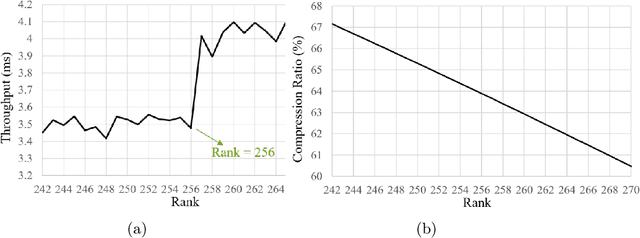

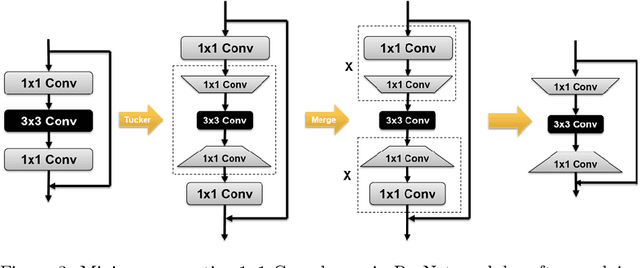
Abstract:Tensor decomposition is a mathematically supported technique for data compression. It consists of applying some kind of a Low Rank Decomposition technique on the tensors or matrices in order to reduce the redundancy of the data. However, it is not a popular technique for compressing the AI models duo to the high number of new layers added to the architecture after decomposition. Although the number of parameters could shrink significantly, it could result in the model be more than twice deeper which could add some latency to the training or inference. In this paper, we present a comprehensive study about how to modify low rank decomposition technique in AI models so that we could benefit from both high accuracy and low memory consumption as well as speeding up the training and inference
Is 3D Convolution with 5D Tensors Really Necessary for Video Analysis?
Jul 23, 2024


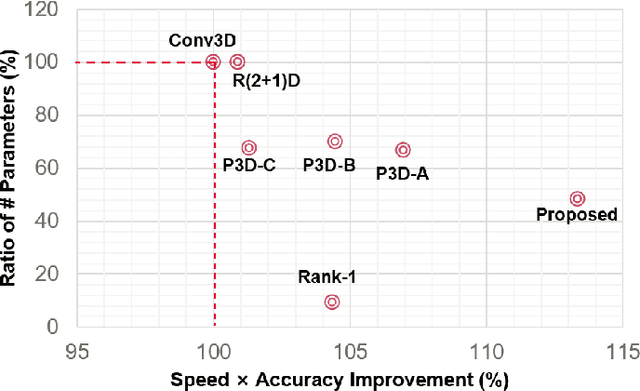
Abstract:In this paper, we present a comprehensive study and propose several novel techniques for implementing 3D convolutional blocks using 2D and/or 1D convolutions with only 4D and/or 3D tensors. Our motivation is that 3D convolutions with 5D tensors are computationally very expensive and they may not be supported by some of the edge devices used in real-time applications such as robots. The existing approaches mitigate this by splitting the 3D kernels into spatial and temporal domains, but they still use 3D convolutions with 5D tensors in their implementations. We resolve this issue by introducing some appropriate 4D/3D tensor reshaping as well as new combination techniques for spatial and temporal splits. The proposed implementation methods show significant improvement both in terms of efficiency and accuracy. The experimental results confirm that the proposed spatio-temporal processing structure outperforms the original model in terms of speed and accuracy using only 4D tensors with fewer parameters.
SkipViT: Speeding Up Vision Transformers with a Token-Level Skip Connection
Jan 27, 2024Abstract:Vision transformers are known to be more computationally and data-intensive than CNN models. These transformer models such as ViT, require all the input image tokens to learn the relationship among them. However, many of these tokens are not informative and may contain irrelevant information such as unrelated background or unimportant scenery. These tokens are overlooked by the multi-head self-attention (MHSA), resulting in many redundant and unnecessary computations in MHSA and the feed-forward network (FFN). In this work, we propose a method to optimize the amount of unnecessary interactions between unimportant tokens by separating and sending them through a different low-cost computational path. Our method does not add any parameters to the ViT model and aims to find the best trade-off between training throughput and achieving a 0% loss in the Top-1 accuracy of the final model. Our experimental results on training ViT-small from scratch show that SkipViT is capable of effectively dropping 55% of the tokens while gaining more than 13% training throughput and maintaining classification accuracy at the level of the baseline model on Huawei Ascend910A.
SwiftLearn: A Data-Efficient Training Method of Deep Learning Models using Importance Sampling
Nov 25, 2023


Abstract:In this paper, we present SwiftLearn, a data-efficient approach to accelerate training of deep learning models using a subset of data samples selected during the warm-up stages of training. This subset is selected based on an importance criteria measured over the entire dataset during warm-up stages, aiming to preserve the model performance with fewer examples during the rest of training. The importance measure we propose could be updated during training every once in a while, to make sure that all of the data samples have a chance to return to the training loop if they show a higher importance. The model architecture is unchanged but since the number of data samples controls the number of forward and backward passes during training, we can reduce the training time by reducing the number of training samples used in each epoch of training. Experimental results on a variety of CV and NLP models during both pretraining and finetuning show that the model performance could be preserved while achieving a significant speed-up during training. More specifically, BERT finetuning on GLUE benchmark shows that almost 90% of the data can be dropped achieving an end-to-end average speedup of 3.36x while keeping the average accuracy drop less than 0.92%.
GQKVA: Efficient Pre-training of Transformers by Grouping Queries, Keys, and Values
Nov 06, 2023Abstract:Massive transformer-based models face several challenges, including slow and computationally intensive pre-training and over-parametrization. This paper addresses these challenges by proposing a versatile method called GQKVA, which generalizes query, key, and value grouping techniques. GQKVA is designed to speed up transformer pre-training while reducing the model size. Our experiments with various GQKVA variants highlight a clear trade-off between performance and model size, allowing for customized choices based on resource and time limitations. Our findings also indicate that the conventional multi-head attention approach is not always the best choice, as there are lighter and faster alternatives available. We tested our method on ViT, which achieved an approximate 0.3% increase in accuracy while reducing the model size by about 4% in the task of image classification. Additionally, our most aggressive model reduction experiment resulted in a reduction of approximately 15% in model size, with only around a 1% drop in accuracy.
Speeding up Resnet Architecture with Layers Targeted Low Rank Decomposition
Sep 21, 2023Abstract:Compression of a neural network can help in speeding up both the training and the inference of the network. In this research, we study applying compression using low rank decomposition on network layers. Our research demonstrates that to acquire a speed up, the compression methodology should be aware of the underlying hardware as analysis should be done to choose which layers to compress. The advantage of our approach is demonstrated via a case study of compressing ResNet50 and training on full ImageNet-ILSVRC2012. We tested on two different hardware systems Nvidia V100 and Huawei Ascend910. With hardware targeted compression, results on Ascend910 showed 5.36% training speedup and 15.79% inference speed on Ascend310 with only 1% drop in accuracy compared to the original uncompressed model
Improving Resnet-9 Generalization Trained on Small Datasets
Sep 07, 2023Abstract:This paper presents our proposed approach that won the first prize at the ICLR competition on Hardware Aware Efficient Training. The challenge is to achieve the highest possible accuracy in an image classification task in less than 10 minutes. The training is done on a small dataset of 5000 images picked randomly from CIFAR-10 dataset. The evaluation is performed by the competition organizers on a secret dataset with 1000 images of the same size. Our approach includes applying a series of technique for improving the generalization of ResNet-9 including: sharpness aware optimization, label smoothing, gradient centralization, input patch whitening as well as metalearning based training. Our experiments show that the ResNet-9 can achieve the accuracy of 88% while trained only on a 10% subset of CIFAR-10 dataset in less than 10 minuets
 Add to Chrome
Add to Chrome Add to Firefox
Add to Firefox Add to Edge
Add to Edge